Business Environment: SWOT Analysis of IKEA and Coca-Cola
VerifiedAdded on 2023/01/18
|13
|3242
|24
AI Summary
This article discusses the concept of business environment and conducts a SWOT analysis of IKEA and Coca-Cola. It explores the internal and external factors that influence business activities and how these companies respond to challenges and opportunities. The analysis provides insights into their strengths, weaknesses, opportunities, and threats.
Contribute Materials
Your contribution can guide someone’s learning journey. Share your
documents today.
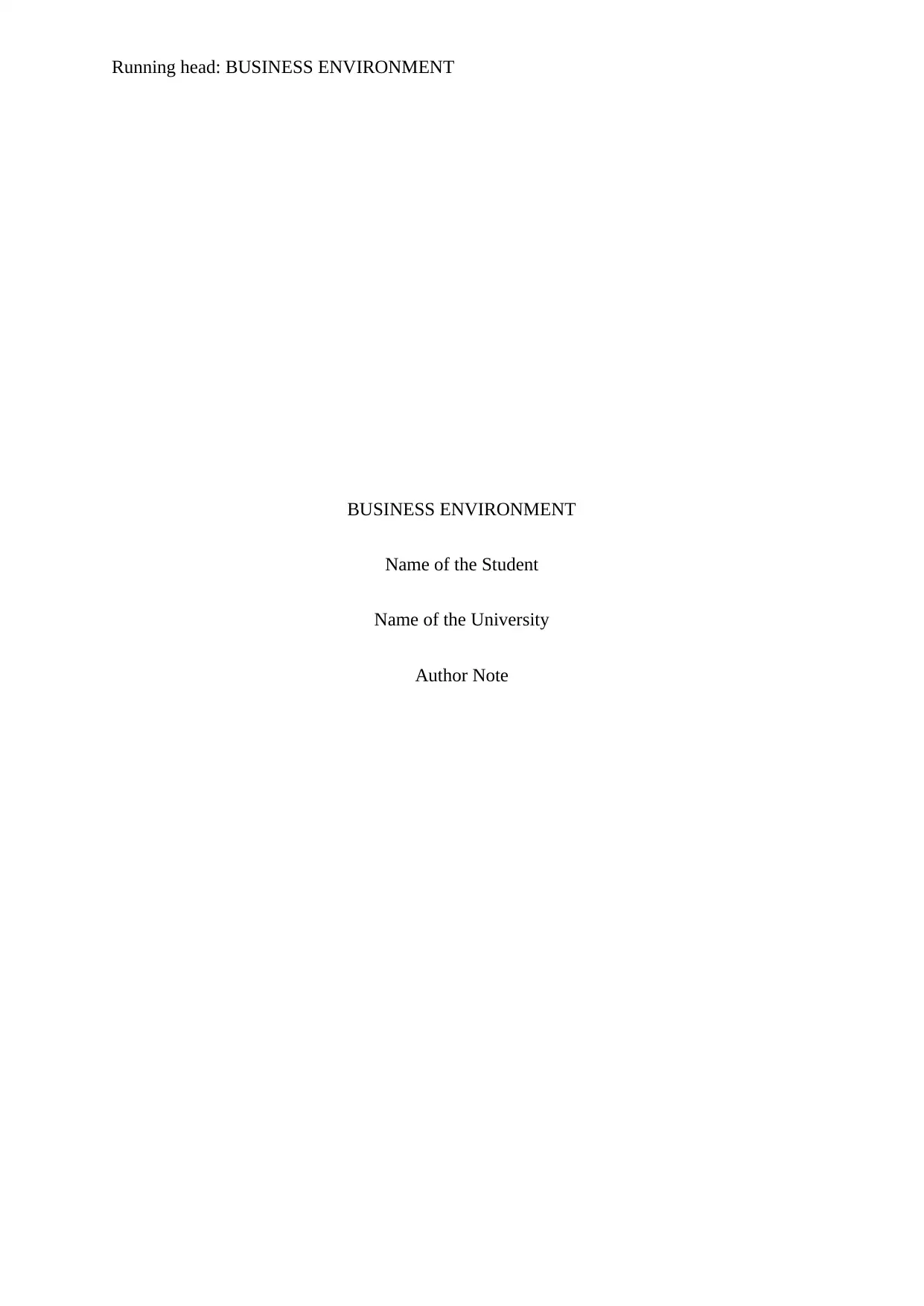
Running head: BUSINESS ENVIRONMENT
BUSINESS ENVIRONMENT
Name of the Student
Name of the University
Author Note
BUSINESS ENVIRONMENT
Name of the Student
Name of the University
Author Note
Secure Best Marks with AI Grader
Need help grading? Try our AI Grader for instant feedback on your assignments.

1BUSINESS ENVIRONMENT
Table of Contents
Introduction................................................................................................................................2
SWOT Analysis:....................................................................................................................2
Difference between internal and external factors:.................................................................3
IKEA responses after SWOT analysis:..................................................................................6
SWOT Analysis of Coca-Cola:..............................................................................................7
Company Overview:..........................................................................................................7
SWOT Analysis:................................................................................................................7
Conclusion:..............................................................................................................................10
Table of Contents
Introduction................................................................................................................................2
SWOT Analysis:....................................................................................................................2
Difference between internal and external factors:.................................................................3
IKEA responses after SWOT analysis:..................................................................................6
SWOT Analysis of Coca-Cola:..............................................................................................7
Company Overview:..........................................................................................................7
SWOT Analysis:................................................................................................................7
Conclusion:..............................................................................................................................10

2BUSINESS ENVIRONMENT
Introduction
The sum of internal and external factors, which influences business activities, is
known as business environment. The external environment comprises of the influences,
which reflects impact on the business operations (Phadermrod, Crowder and Wills 2019,
pp.194). The internal environment is comprised of constituents in the organization, which
includes management, existing employees and corporate culture. The purpose of the paper is
to discuss about the concepts of internal and external environment with respect of Ikea.
SWOT Analysis:
The strategic planning approach, which is used for helping an organization for the
identification of strengths, weaknesses, opportunities and threats in regards with the business
competition or/and project planning. The purpose of the SWOT analysis is to depict the
objectives of business ventures followed with the identification of external and internal
factors, which reflects the favorability and challenges in the process of fulfilling the
objectives (Gürel and Tat 2017, pp.51). The analytical framework is used for identifying the
competitive advantages of businesses. It is considered to be one of the crucial tools of
strategic planning.
Strengths are the qualities of an organization, which are possessed internally. It
reflects the success factors of an organization in regards with the existing competition. The
advantages of the organization over competitors or the Unique Selling Point are reflected in
the ‘strengths’ of a SWOT analysis. It may include the quality, the pricing structure or the
valuable customer service experience of an organization. Weaknesses reflect the regions or
departments where organizations need improvement (Phadermrod, Crowder and Wills 2019,
pp.194). The strengths of the competitors can be considered as the source of weaknesses. The
lower market share, poor reputation, low cash reserves and questionable presence in the
market acts as weaknesses in organizations. The areas where the company can excel reflect
Introduction
The sum of internal and external factors, which influences business activities, is
known as business environment. The external environment comprises of the influences,
which reflects impact on the business operations (Phadermrod, Crowder and Wills 2019,
pp.194). The internal environment is comprised of constituents in the organization, which
includes management, existing employees and corporate culture. The purpose of the paper is
to discuss about the concepts of internal and external environment with respect of Ikea.
SWOT Analysis:
The strategic planning approach, which is used for helping an organization for the
identification of strengths, weaknesses, opportunities and threats in regards with the business
competition or/and project planning. The purpose of the SWOT analysis is to depict the
objectives of business ventures followed with the identification of external and internal
factors, which reflects the favorability and challenges in the process of fulfilling the
objectives (Gürel and Tat 2017, pp.51). The analytical framework is used for identifying the
competitive advantages of businesses. It is considered to be one of the crucial tools of
strategic planning.
Strengths are the qualities of an organization, which are possessed internally. It
reflects the success factors of an organization in regards with the existing competition. The
advantages of the organization over competitors or the Unique Selling Point are reflected in
the ‘strengths’ of a SWOT analysis. It may include the quality, the pricing structure or the
valuable customer service experience of an organization. Weaknesses reflect the regions or
departments where organizations need improvement (Phadermrod, Crowder and Wills 2019,
pp.194). The strengths of the competitors can be considered as the source of weaknesses. The
lower market share, poor reputation, low cash reserves and questionable presence in the
market acts as weaknesses in organizations. The areas where the company can excel reflect
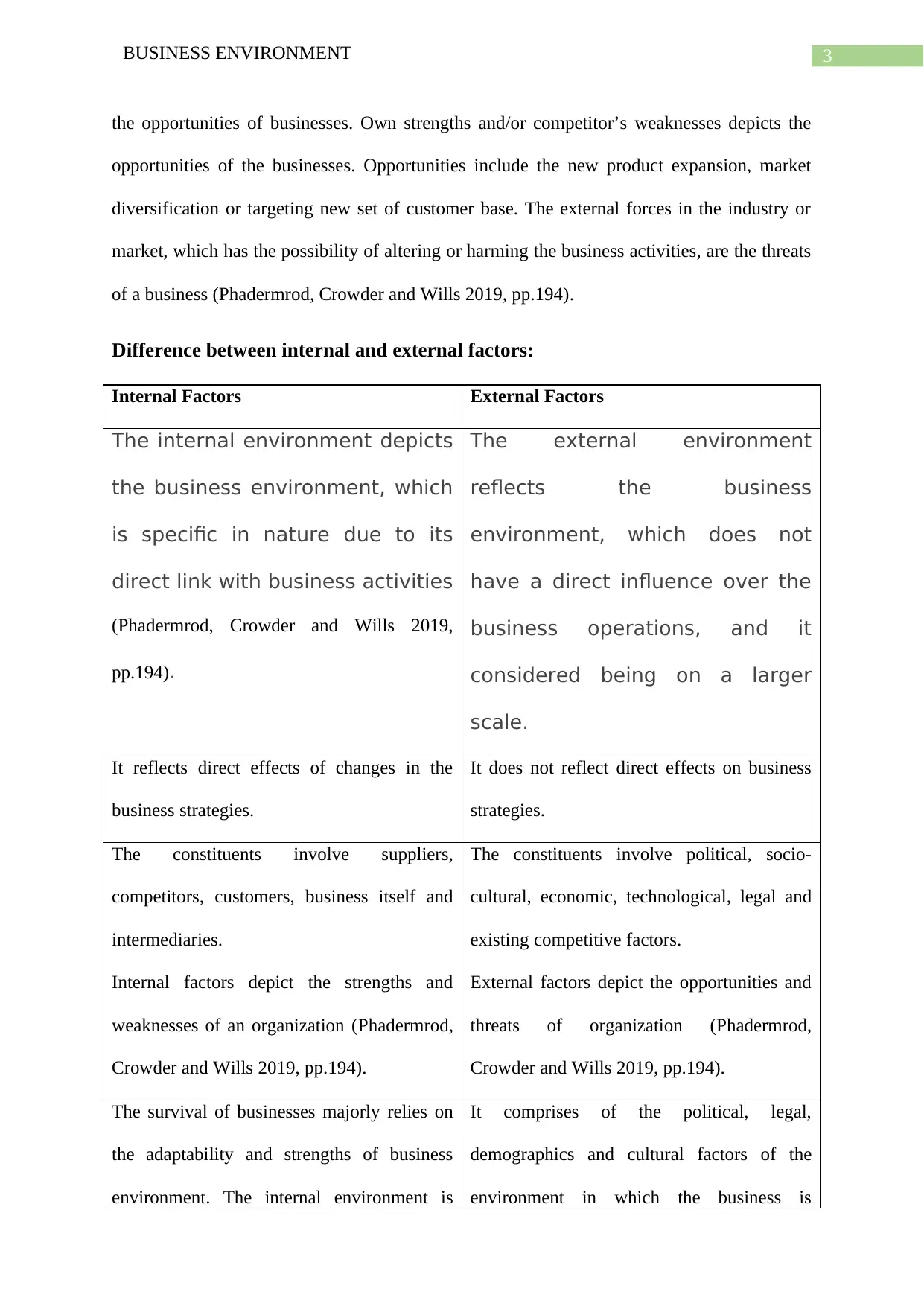
3BUSINESS ENVIRONMENT
the opportunities of businesses. Own strengths and/or competitor’s weaknesses depicts the
opportunities of the businesses. Opportunities include the new product expansion, market
diversification or targeting new set of customer base. The external forces in the industry or
market, which has the possibility of altering or harming the business activities, are the threats
of a business (Phadermrod, Crowder and Wills 2019, pp.194).
Difference between internal and external factors:
Internal Factors External Factors
The internal environment depicts
the business environment, which
is specific in nature due to its
direct link with business activities
(Phadermrod, Crowder and Wills 2019,
pp.194).
The external environment
reflects the business
environment, which does not
have a direct influence over the
business operations, and it
considered being on a larger
scale.
It reflects direct effects of changes in the
business strategies.
It does not reflect direct effects on business
strategies.
The constituents involve suppliers,
competitors, customers, business itself and
intermediaries.
Internal factors depict the strengths and
weaknesses of an organization (Phadermrod,
Crowder and Wills 2019, pp.194).
The constituents involve political, socio-
cultural, economic, technological, legal and
existing competitive factors.
External factors depict the opportunities and
threats of organization (Phadermrod,
Crowder and Wills 2019, pp.194).
The survival of businesses majorly relies on
the adaptability and strengths of business
environment. The internal environment is
It comprises of the political, legal,
demographics and cultural factors of the
environment in which the business is
the opportunities of businesses. Own strengths and/or competitor’s weaknesses depicts the
opportunities of the businesses. Opportunities include the new product expansion, market
diversification or targeting new set of customer base. The external forces in the industry or
market, which has the possibility of altering or harming the business activities, are the threats
of a business (Phadermrod, Crowder and Wills 2019, pp.194).
Difference between internal and external factors:
Internal Factors External Factors
The internal environment depicts
the business environment, which
is specific in nature due to its
direct link with business activities
(Phadermrod, Crowder and Wills 2019,
pp.194).
The external environment
reflects the business
environment, which does not
have a direct influence over the
business operations, and it
considered being on a larger
scale.
It reflects direct effects of changes in the
business strategies.
It does not reflect direct effects on business
strategies.
The constituents involve suppliers,
competitors, customers, business itself and
intermediaries.
Internal factors depict the strengths and
weaknesses of an organization (Phadermrod,
Crowder and Wills 2019, pp.194).
The constituents involve political, socio-
cultural, economic, technological, legal and
existing competitive factors.
External factors depict the opportunities and
threats of organization (Phadermrod,
Crowder and Wills 2019, pp.194).
The survival of businesses majorly relies on
the adaptability and strengths of business
environment. The internal environment is
It comprises of the political, legal,
demographics and cultural factors of the
environment in which the business is
Secure Best Marks with AI Grader
Need help grading? Try our AI Grader for instant feedback on your assignments.
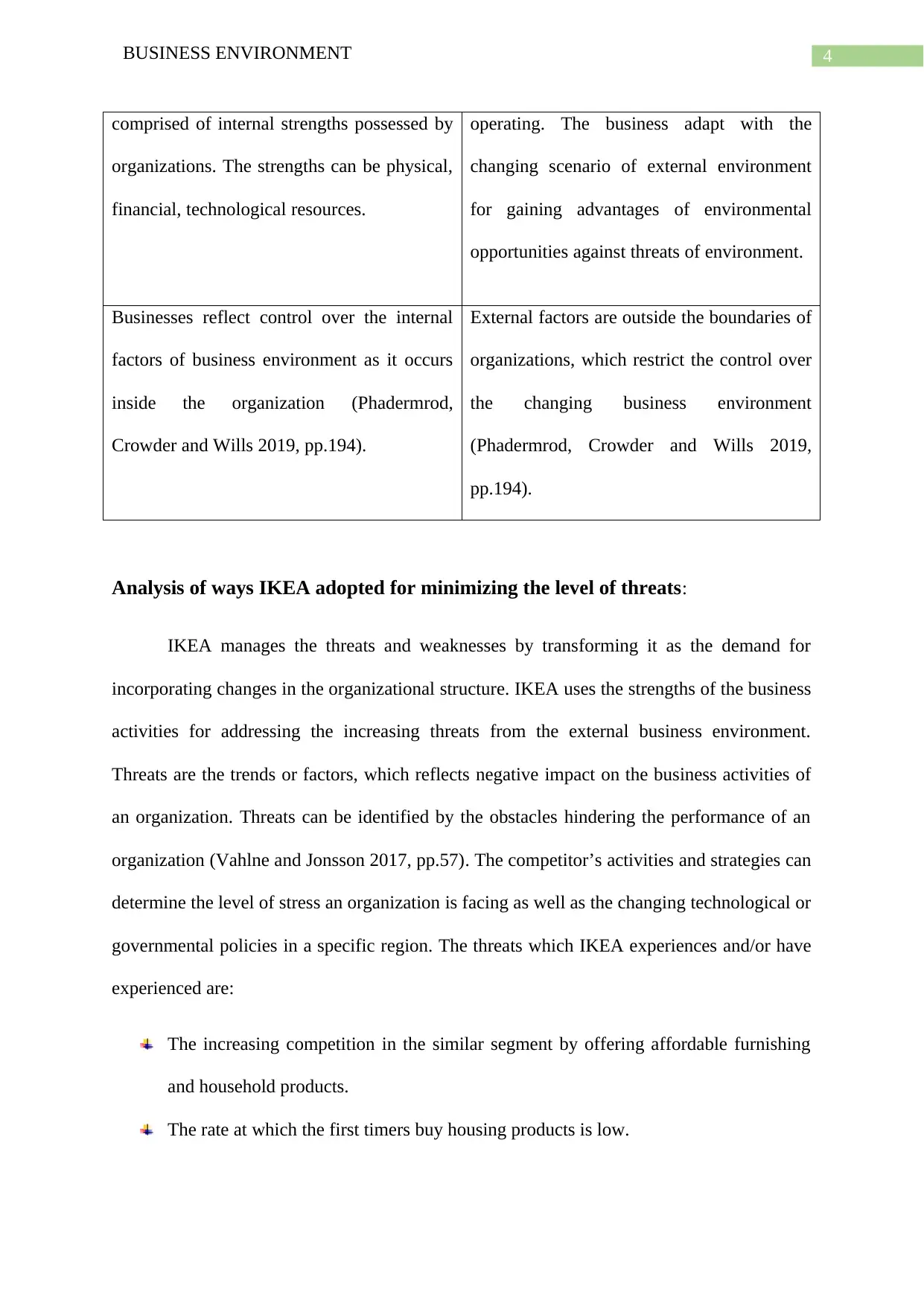
4BUSINESS ENVIRONMENT
comprised of internal strengths possessed by
organizations. The strengths can be physical,
financial, technological resources.
operating. The business adapt with the
changing scenario of external environment
for gaining advantages of environmental
opportunities against threats of environment.
Businesses reflect control over the internal
factors of business environment as it occurs
inside the organization (Phadermrod,
Crowder and Wills 2019, pp.194).
External factors are outside the boundaries of
organizations, which restrict the control over
the changing business environment
(Phadermrod, Crowder and Wills 2019,
pp.194).
Analysis of ways IKEA adopted for minimizing the level of threats:
IKEA manages the threats and weaknesses by transforming it as the demand for
incorporating changes in the organizational structure. IKEA uses the strengths of the business
activities for addressing the increasing threats from the external business environment.
Threats are the trends or factors, which reflects negative impact on the business activities of
an organization. Threats can be identified by the obstacles hindering the performance of an
organization (Vahlne and Jonsson 2017, pp.57). The competitor’s activities and strategies can
determine the level of stress an organization is facing as well as the changing technological or
governmental policies in a specific region. The threats which IKEA experiences and/or have
experienced are:
The increasing competition in the similar segment by offering affordable furnishing
and household products.
The rate at which the first timers buy housing products is low.
comprised of internal strengths possessed by
organizations. The strengths can be physical,
financial, technological resources.
operating. The business adapt with the
changing scenario of external environment
for gaining advantages of environmental
opportunities against threats of environment.
Businesses reflect control over the internal
factors of business environment as it occurs
inside the organization (Phadermrod,
Crowder and Wills 2019, pp.194).
External factors are outside the boundaries of
organizations, which restrict the control over
the changing business environment
(Phadermrod, Crowder and Wills 2019,
pp.194).
Analysis of ways IKEA adopted for minimizing the level of threats:
IKEA manages the threats and weaknesses by transforming it as the demand for
incorporating changes in the organizational structure. IKEA uses the strengths of the business
activities for addressing the increasing threats from the external business environment.
Threats are the trends or factors, which reflects negative impact on the business activities of
an organization. Threats can be identified by the obstacles hindering the performance of an
organization (Vahlne and Jonsson 2017, pp.57). The competitor’s activities and strategies can
determine the level of stress an organization is facing as well as the changing technological or
governmental policies in a specific region. The threats which IKEA experiences and/or have
experienced are:
The increasing competition in the similar segment by offering affordable furnishing
and household products.
The rate at which the first timers buy housing products is low.

5BUSINESS ENVIRONMENT
The changing economic condition of a specific country also affects the consumer
spending and income rates.
IKEA analyses the threats through business environment analysis of the region the store is
operating in and changes the threats into opportunities by incorporating strategies and
strengths. IKEA adopted various ways for addressing the threats:
For addressing the increasing competition offering affordable furnishing, IKEA
utilizes ‘quality with affordability’ as its Unique Selling Point (Chiaroni and Urbinati
2017, pp.14).
IKEA have incorporated sustainable approach in every step of its operation activities
for improving the corporate responsibility of the organization and to minimize the
carbon footprint of the business (Wangsirilert and Simon 2017, pp.55).
To address the changing social trends IKEA have planned for introducing customer
service facility as a means of help for the customers by using the features of online
platform. The online help will act as a guide for encouraging a sustainable life
(Boström et al. 2015, pp.3). The online presence of IKEA will offer assistance for
reducing the impacts on environment followed with the tips for saving money in
owning a functional and quality furnishing structure (Suárez-Ruiz, Zhou and Pham
2018, pp.17).
IKEA have trained the employees working in various IKEA store for adopting
sustainable ways for the operational activities in the business as well as the company
encourages them to incorporate sustainability in their day-to-day life (Daunfeldt et al.
2017, pp.313).
The increasing competition in the similar segment is addresses by using the strength
of large economies of scale. Economies of scale helps IKEA in lowering the costs of
production and/or sourcing, which in return contributes towards lowering the final
The changing economic condition of a specific country also affects the consumer
spending and income rates.
IKEA analyses the threats through business environment analysis of the region the store is
operating in and changes the threats into opportunities by incorporating strategies and
strengths. IKEA adopted various ways for addressing the threats:
For addressing the increasing competition offering affordable furnishing, IKEA
utilizes ‘quality with affordability’ as its Unique Selling Point (Chiaroni and Urbinati
2017, pp.14).
IKEA have incorporated sustainable approach in every step of its operation activities
for improving the corporate responsibility of the organization and to minimize the
carbon footprint of the business (Wangsirilert and Simon 2017, pp.55).
To address the changing social trends IKEA have planned for introducing customer
service facility as a means of help for the customers by using the features of online
platform. The online help will act as a guide for encouraging a sustainable life
(Boström et al. 2015, pp.3). The online presence of IKEA will offer assistance for
reducing the impacts on environment followed with the tips for saving money in
owning a functional and quality furnishing structure (Suárez-Ruiz, Zhou and Pham
2018, pp.17).
IKEA have trained the employees working in various IKEA store for adopting
sustainable ways for the operational activities in the business as well as the company
encourages them to incorporate sustainability in their day-to-day life (Daunfeldt et al.
2017, pp.313).
The increasing competition in the similar segment is addresses by using the strength
of large economies of scale. Economies of scale helps IKEA in lowering the costs of
production and/or sourcing, which in return contributes towards lowering the final

6BUSINESS ENVIRONMENT
price of the offered products. IKEA have mastered the process of including
technological advances and sustainable innovative measures (Cosmo and Yang 2017,
pp.2). The ability to offer quality product at affordable prices can be achieved by a
strategic and efficient supply chain, which makes the barriers of entry high in the
specific segment.
IKEA responds to the changing economic factors by maintaining the lower prices of
products, which contributes positively towards maintaining the growth of the business
at the time of depressed financial times. Even at the time of depressing situation of
retail sector, IKEA maintains the profitability and customer base by keeping the
prices low (Sarstedt, Neubert and Barth 2017, pp.307).
The company ensures the customer engagement by communicating the affordable
pricing structure of the products.
IKEA responses after SWOT analysis:
How did IKEA use the information in their SWOT analysis to help their business grow?
IKEA is a well-reputed company with large-scale business operation all across the
world. The strategies of IKEA respond to the external and internal challenges identified by
SWOT analysis. It incorporates strategic approaches and functions for maintaining the
progressive growth of the business as well as for the purpose of maintaining strong identity.
The main objective of IKEA is to combine low prices, quality, innovative functional design,
and responsibilities for environment and people as well as it focuses on the sustainable use of
resources and raw materials. The strategic planning for minimal and effective packaging of
products (furnishing elements) helps in using the self-safe efficiently and it also contributes
towards the lower cost of delivery. This example depicts the initiative adopted by IKEA for
aligning the activities with the factors of responsiveness. The company is majorly involved in
connecting quality with affordability as well as it aims at becoming a complete sustainable
business rather than just being reputed and profitable. By the introduction of online assistance
price of the offered products. IKEA have mastered the process of including
technological advances and sustainable innovative measures (Cosmo and Yang 2017,
pp.2). The ability to offer quality product at affordable prices can be achieved by a
strategic and efficient supply chain, which makes the barriers of entry high in the
specific segment.
IKEA responds to the changing economic factors by maintaining the lower prices of
products, which contributes positively towards maintaining the growth of the business
at the time of depressed financial times. Even at the time of depressing situation of
retail sector, IKEA maintains the profitability and customer base by keeping the
prices low (Sarstedt, Neubert and Barth 2017, pp.307).
The company ensures the customer engagement by communicating the affordable
pricing structure of the products.
IKEA responses after SWOT analysis:
How did IKEA use the information in their SWOT analysis to help their business grow?
IKEA is a well-reputed company with large-scale business operation all across the
world. The strategies of IKEA respond to the external and internal challenges identified by
SWOT analysis. It incorporates strategic approaches and functions for maintaining the
progressive growth of the business as well as for the purpose of maintaining strong identity.
The main objective of IKEA is to combine low prices, quality, innovative functional design,
and responsibilities for environment and people as well as it focuses on the sustainable use of
resources and raw materials. The strategic planning for minimal and effective packaging of
products (furnishing elements) helps in using the self-safe efficiently and it also contributes
towards the lower cost of delivery. This example depicts the initiative adopted by IKEA for
aligning the activities with the factors of responsiveness. The company is majorly involved in
connecting quality with affordability as well as it aims at becoming a complete sustainable
business rather than just being reputed and profitable. By the introduction of online assistance
Paraphrase This Document
Need a fresh take? Get an instant paraphrase of this document with our AI Paraphraser
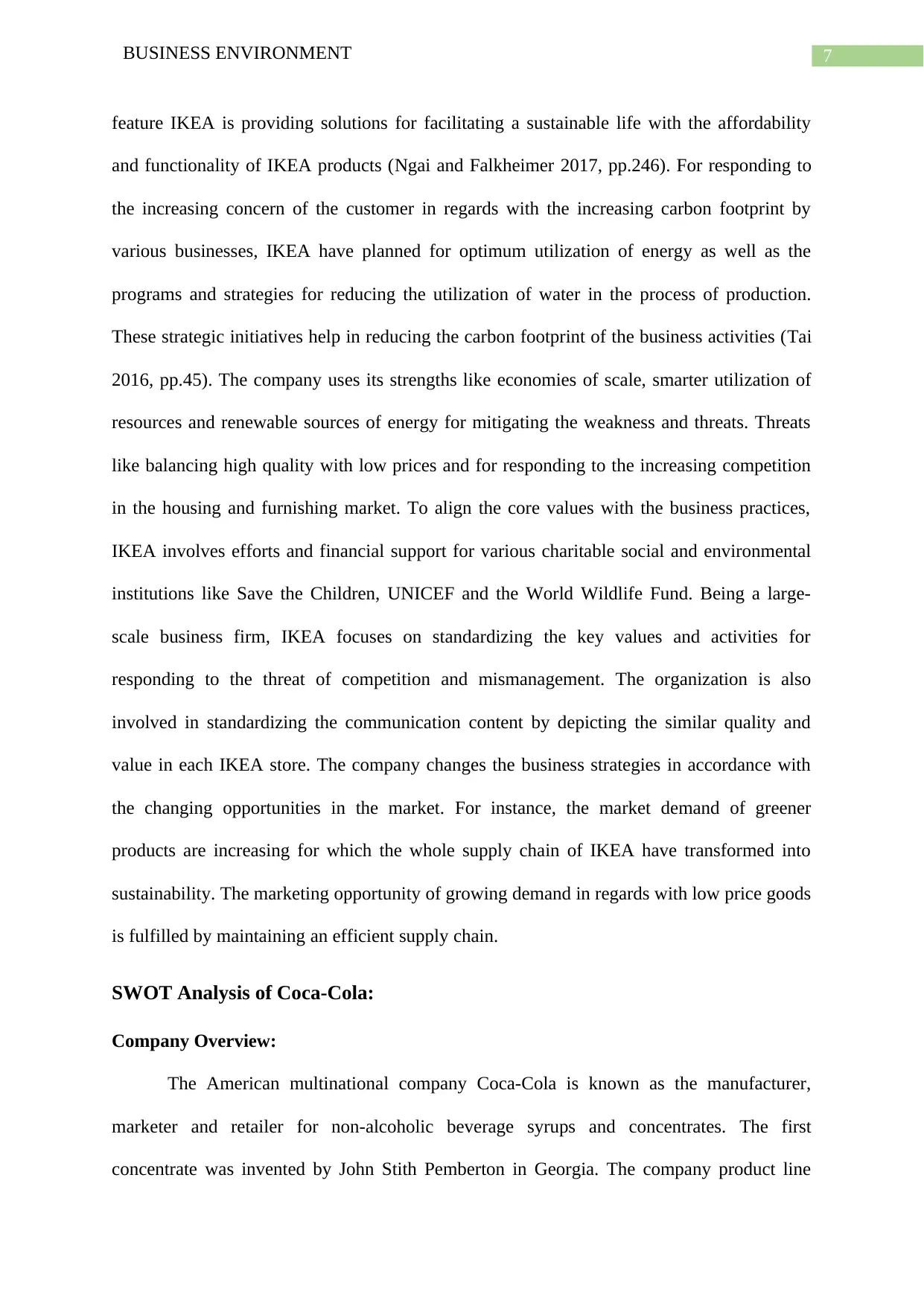
7BUSINESS ENVIRONMENT
feature IKEA is providing solutions for facilitating a sustainable life with the affordability
and functionality of IKEA products (Ngai and Falkheimer 2017, pp.246). For responding to
the increasing concern of the customer in regards with the increasing carbon footprint by
various businesses, IKEA have planned for optimum utilization of energy as well as the
programs and strategies for reducing the utilization of water in the process of production.
These strategic initiatives help in reducing the carbon footprint of the business activities (Tai
2016, pp.45). The company uses its strengths like economies of scale, smarter utilization of
resources and renewable sources of energy for mitigating the weakness and threats. Threats
like balancing high quality with low prices and for responding to the increasing competition
in the housing and furnishing market. To align the core values with the business practices,
IKEA involves efforts and financial support for various charitable social and environmental
institutions like Save the Children, UNICEF and the World Wildlife Fund. Being a large-
scale business firm, IKEA focuses on standardizing the key values and activities for
responding to the threat of competition and mismanagement. The organization is also
involved in standardizing the communication content by depicting the similar quality and
value in each IKEA store. The company changes the business strategies in accordance with
the changing opportunities in the market. For instance, the market demand of greener
products are increasing for which the whole supply chain of IKEA have transformed into
sustainability. The marketing opportunity of growing demand in regards with low price goods
is fulfilled by maintaining an efficient supply chain.
SWOT Analysis of Coca-Cola:
Company Overview:
The American multinational company Coca-Cola is known as the manufacturer,
marketer and retailer for non-alcoholic beverage syrups and concentrates. The first
concentrate was invented by John Stith Pemberton in Georgia. The company product line
feature IKEA is providing solutions for facilitating a sustainable life with the affordability
and functionality of IKEA products (Ngai and Falkheimer 2017, pp.246). For responding to
the increasing concern of the customer in regards with the increasing carbon footprint by
various businesses, IKEA have planned for optimum utilization of energy as well as the
programs and strategies for reducing the utilization of water in the process of production.
These strategic initiatives help in reducing the carbon footprint of the business activities (Tai
2016, pp.45). The company uses its strengths like economies of scale, smarter utilization of
resources and renewable sources of energy for mitigating the weakness and threats. Threats
like balancing high quality with low prices and for responding to the increasing competition
in the housing and furnishing market. To align the core values with the business practices,
IKEA involves efforts and financial support for various charitable social and environmental
institutions like Save the Children, UNICEF and the World Wildlife Fund. Being a large-
scale business firm, IKEA focuses on standardizing the key values and activities for
responding to the threat of competition and mismanagement. The organization is also
involved in standardizing the communication content by depicting the similar quality and
value in each IKEA store. The company changes the business strategies in accordance with
the changing opportunities in the market. For instance, the market demand of greener
products are increasing for which the whole supply chain of IKEA have transformed into
sustainability. The marketing opportunity of growing demand in regards with low price goods
is fulfilled by maintaining an efficient supply chain.
SWOT Analysis of Coca-Cola:
Company Overview:
The American multinational company Coca-Cola is known as the manufacturer,
marketer and retailer for non-alcoholic beverage syrups and concentrates. The first
concentrate was invented by John Stith Pemberton in Georgia. The company product line
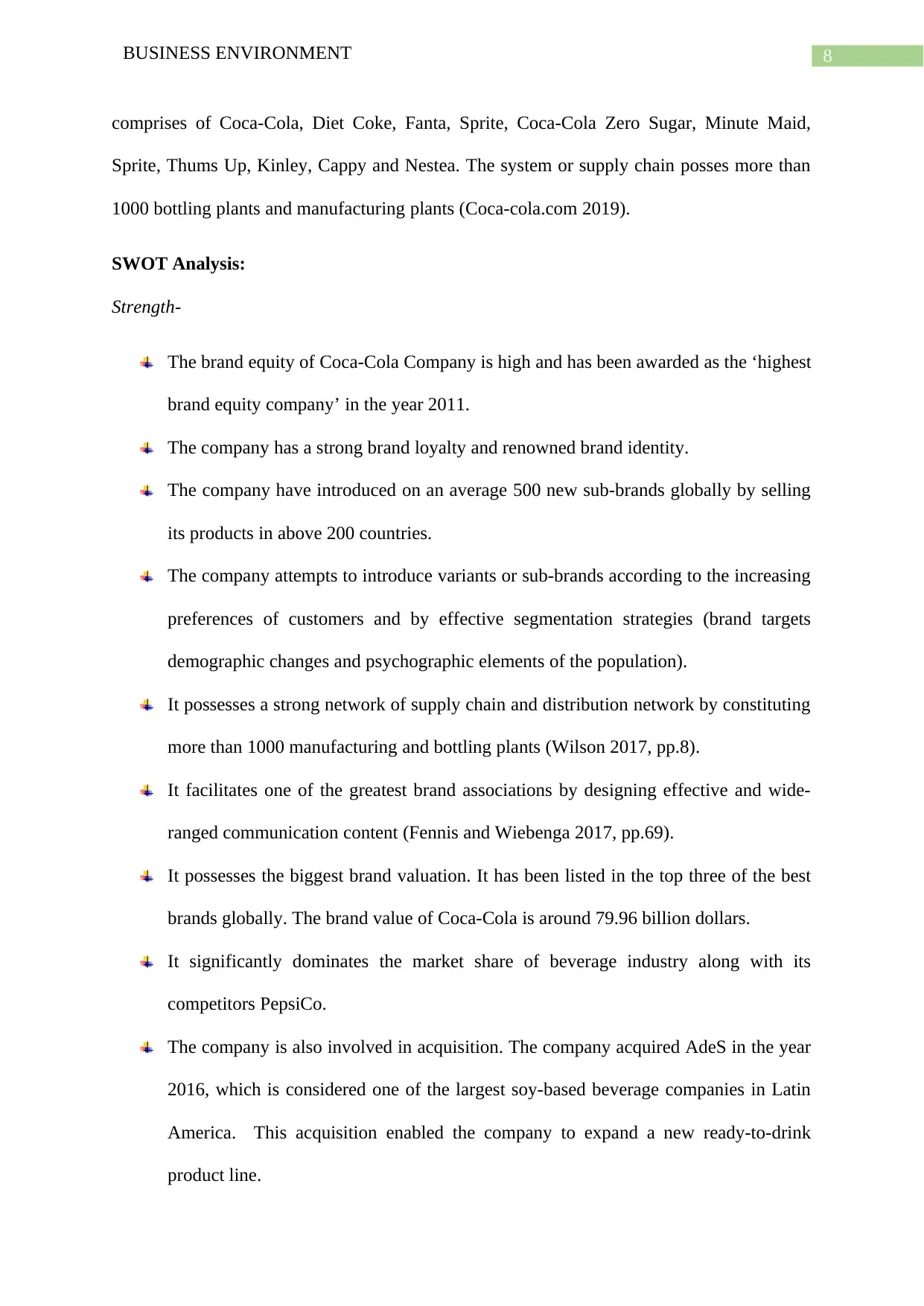
8BUSINESS ENVIRONMENT
comprises of Coca-Cola, Diet Coke, Fanta, Sprite, Coca-Cola Zero Sugar, Minute Maid,
Sprite, Thums Up, Kinley, Cappy and Nestea. The system or supply chain posses more than
1000 bottling plants and manufacturing plants (Coca-cola.com 2019).
SWOT Analysis:
Strength-
The brand equity of Coca-Cola Company is high and has been awarded as the ‘highest
brand equity company’ in the year 2011.
The company has a strong brand loyalty and renowned brand identity.
The company have introduced on an average 500 new sub-brands globally by selling
its products in above 200 countries.
The company attempts to introduce variants or sub-brands according to the increasing
preferences of customers and by effective segmentation strategies (brand targets
demographic changes and psychographic elements of the population).
It possesses a strong network of supply chain and distribution network by constituting
more than 1000 manufacturing and bottling plants (Wilson 2017, pp.8).
It facilitates one of the greatest brand associations by designing effective and wide-
ranged communication content (Fennis and Wiebenga 2017, pp.69).
It possesses the biggest brand valuation. It has been listed in the top three of the best
brands globally. The brand value of Coca-Cola is around 79.96 billion dollars.
It significantly dominates the market share of beverage industry along with its
competitors PepsiCo.
The company is also involved in acquisition. The company acquired AdeS in the year
2016, which is considered one of the largest soy-based beverage companies in Latin
America. This acquisition enabled the company to expand a new ready-to-drink
product line.
comprises of Coca-Cola, Diet Coke, Fanta, Sprite, Coca-Cola Zero Sugar, Minute Maid,
Sprite, Thums Up, Kinley, Cappy and Nestea. The system or supply chain posses more than
1000 bottling plants and manufacturing plants (Coca-cola.com 2019).
SWOT Analysis:
Strength-
The brand equity of Coca-Cola Company is high and has been awarded as the ‘highest
brand equity company’ in the year 2011.
The company has a strong brand loyalty and renowned brand identity.
The company have introduced on an average 500 new sub-brands globally by selling
its products in above 200 countries.
The company attempts to introduce variants or sub-brands according to the increasing
preferences of customers and by effective segmentation strategies (brand targets
demographic changes and psychographic elements of the population).
It possesses a strong network of supply chain and distribution network by constituting
more than 1000 manufacturing and bottling plants (Wilson 2017, pp.8).
It facilitates one of the greatest brand associations by designing effective and wide-
ranged communication content (Fennis and Wiebenga 2017, pp.69).
It possesses the biggest brand valuation. It has been listed in the top three of the best
brands globally. The brand value of Coca-Cola is around 79.96 billion dollars.
It significantly dominates the market share of beverage industry along with its
competitors PepsiCo.
The company is also involved in acquisition. The company acquired AdeS in the year
2016, which is considered one of the largest soy-based beverage companies in Latin
America. This acquisition enabled the company to expand a new ready-to-drink
product line.
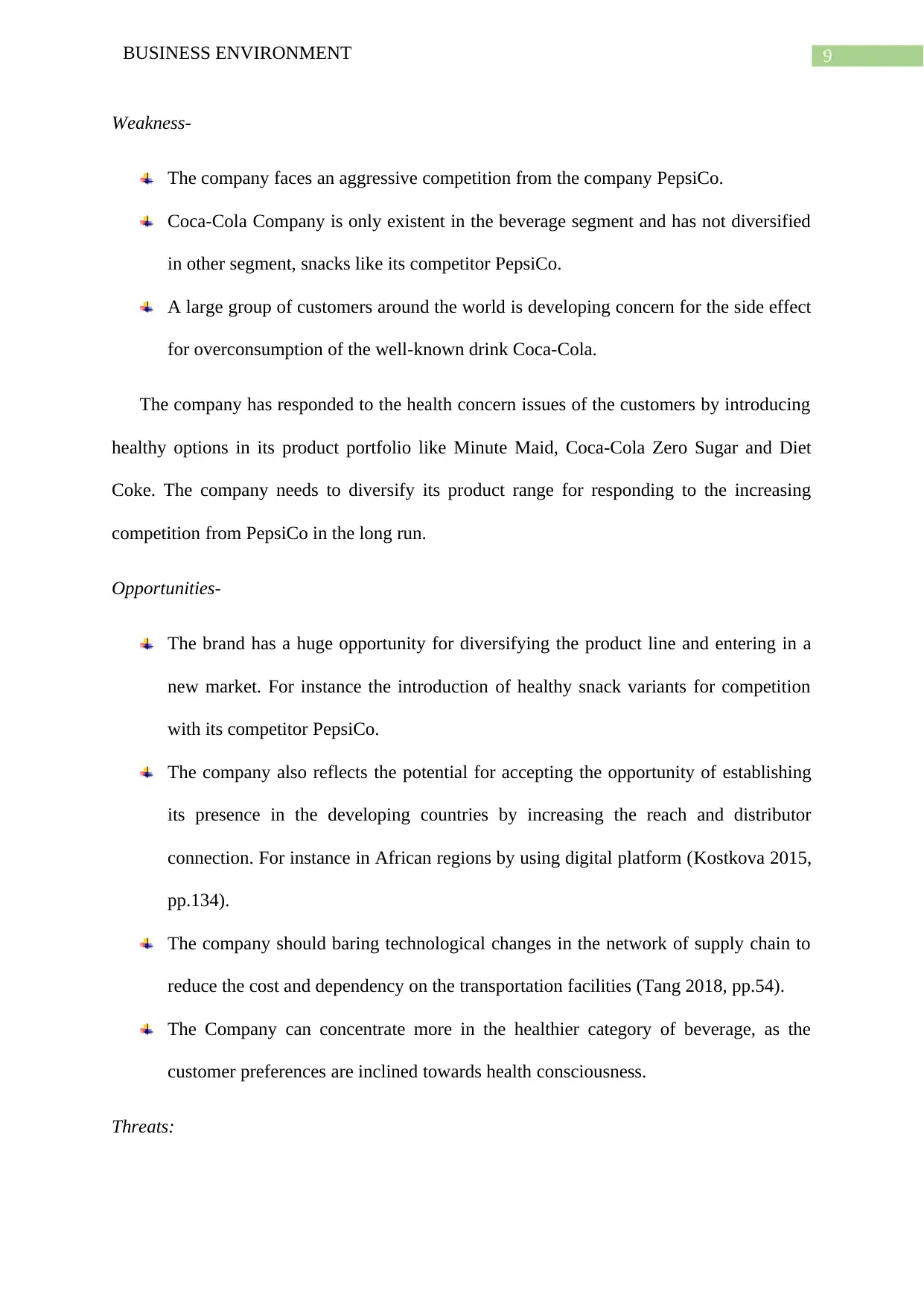
9BUSINESS ENVIRONMENT
Weakness-
The company faces an aggressive competition from the company PepsiCo.
Coca-Cola Company is only existent in the beverage segment and has not diversified
in other segment, snacks like its competitor PepsiCo.
A large group of customers around the world is developing concern for the side effect
for overconsumption of the well-known drink Coca-Cola.
The company has responded to the health concern issues of the customers by introducing
healthy options in its product portfolio like Minute Maid, Coca-Cola Zero Sugar and Diet
Coke. The company needs to diversify its product range for responding to the increasing
competition from PepsiCo in the long run.
Opportunities-
The brand has a huge opportunity for diversifying the product line and entering in a
new market. For instance the introduction of healthy snack variants for competition
with its competitor PepsiCo.
The company also reflects the potential for accepting the opportunity of establishing
its presence in the developing countries by increasing the reach and distributor
connection. For instance in African regions by using digital platform (Kostkova 2015,
pp.134).
The company should baring technological changes in the network of supply chain to
reduce the cost and dependency on the transportation facilities (Tang 2018, pp.54).
The Company can concentrate more in the healthier category of beverage, as the
customer preferences are inclined towards health consciousness.
Threats:
Weakness-
The company faces an aggressive competition from the company PepsiCo.
Coca-Cola Company is only existent in the beverage segment and has not diversified
in other segment, snacks like its competitor PepsiCo.
A large group of customers around the world is developing concern for the side effect
for overconsumption of the well-known drink Coca-Cola.
The company has responded to the health concern issues of the customers by introducing
healthy options in its product portfolio like Minute Maid, Coca-Cola Zero Sugar and Diet
Coke. The company needs to diversify its product range for responding to the increasing
competition from PepsiCo in the long run.
Opportunities-
The brand has a huge opportunity for diversifying the product line and entering in a
new market. For instance the introduction of healthy snack variants for competition
with its competitor PepsiCo.
The company also reflects the potential for accepting the opportunity of establishing
its presence in the developing countries by increasing the reach and distributor
connection. For instance in African regions by using digital platform (Kostkova 2015,
pp.134).
The company should baring technological changes in the network of supply chain to
reduce the cost and dependency on the transportation facilities (Tang 2018, pp.54).
The Company can concentrate more in the healthier category of beverage, as the
customer preferences are inclined towards health consciousness.
Threats:
Secure Best Marks with AI Grader
Need help grading? Try our AI Grader for instant feedback on your assignments.

10BUSINESS ENVIRONMENT
Coca-Cola Company have experienced criticism regarding the water usage
management as it was claimed by many environmental and social groups that the
company is engaging in vast-consumption of water resources, even in the water-
scarce areas.
The company is also experiencing a packaging controversy as it uses large quantity
plastic and metal for packaging purposes (Boström et al. 2015, pp.3).
The biggest and considerably the only competitor of Coca-Cola, PepsiCo is growing
at a faster rate by involving diversification strategies.
The company has to improve the process of resource consumption by involving
renewable sources and by incorporating recycling and sustainable approaches throughout the
supply chain network (Abed 2018, pp.107).
Conclusion:
Therefore, it can be concluded from the paper that organizations should conduct
SWOT analysis for understanding the market potential and risks regarding the approaches
and practices. Organizations should assess the weaknesses and threats for planning effective
mitigation strategies by the utilization of strengths.
Coca-Cola Company have experienced criticism regarding the water usage
management as it was claimed by many environmental and social groups that the
company is engaging in vast-consumption of water resources, even in the water-
scarce areas.
The company is also experiencing a packaging controversy as it uses large quantity
plastic and metal for packaging purposes (Boström et al. 2015, pp.3).
The biggest and considerably the only competitor of Coca-Cola, PepsiCo is growing
at a faster rate by involving diversification strategies.
The company has to improve the process of resource consumption by involving
renewable sources and by incorporating recycling and sustainable approaches throughout the
supply chain network (Abed 2018, pp.107).
Conclusion:
Therefore, it can be concluded from the paper that organizations should conduct
SWOT analysis for understanding the market potential and risks regarding the approaches
and practices. Organizations should assess the weaknesses and threats for planning effective
mitigation strategies by the utilization of strengths.
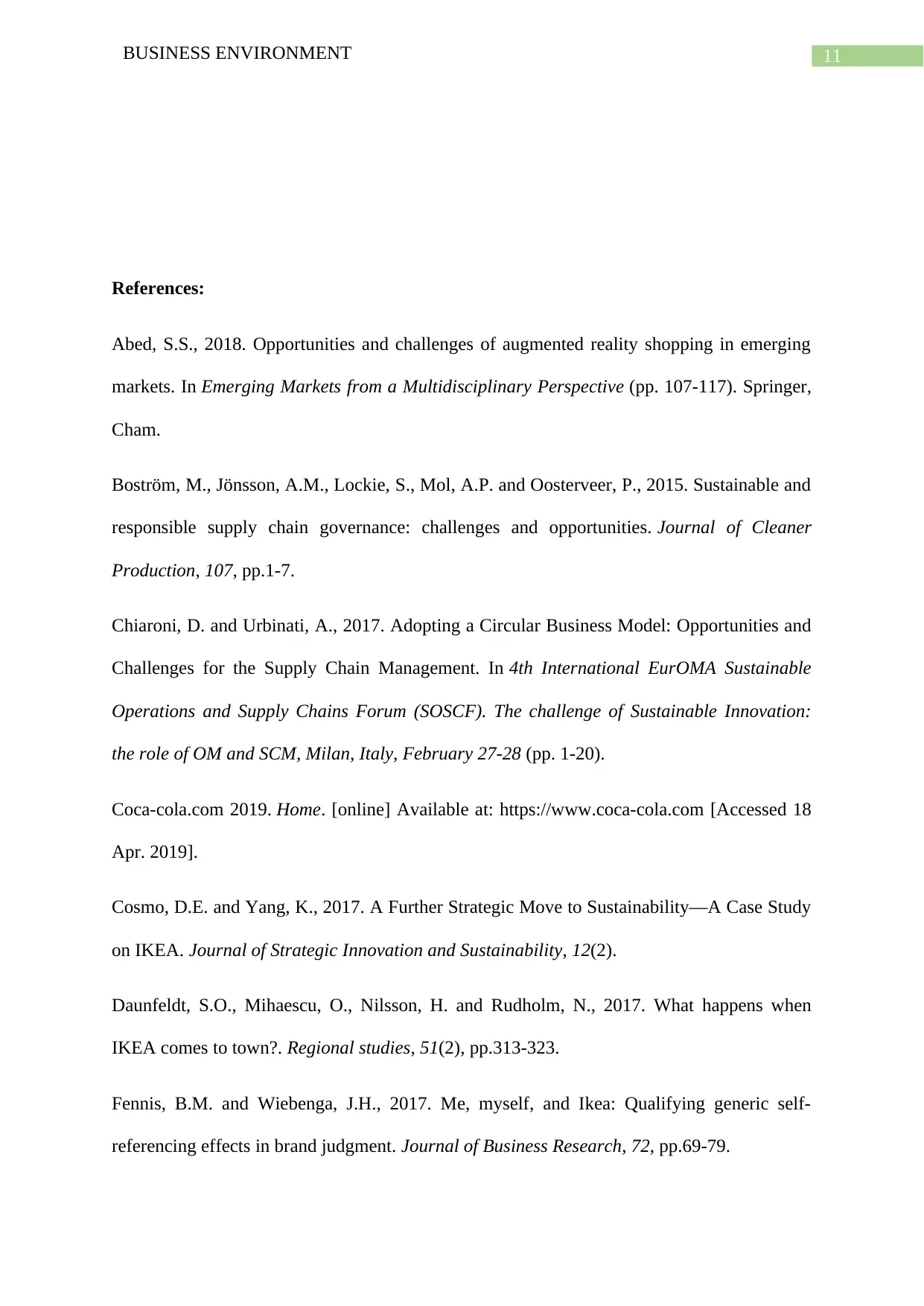
11BUSINESS ENVIRONMENT
References:
Abed, S.S., 2018. Opportunities and challenges of augmented reality shopping in emerging
markets. In Emerging Markets from a Multidisciplinary Perspective (pp. 107-117). Springer,
Cham.
Boström, M., Jönsson, A.M., Lockie, S., Mol, A.P. and Oosterveer, P., 2015. Sustainable and
responsible supply chain governance: challenges and opportunities. Journal of Cleaner
Production, 107, pp.1-7.
Chiaroni, D. and Urbinati, A., 2017. Adopting a Circular Business Model: Opportunities and
Challenges for the Supply Chain Management. In 4th International EurOMA Sustainable
Operations and Supply Chains Forum (SOSCF). The challenge of Sustainable Innovation:
the role of OM and SCM, Milan, Italy, February 27-28 (pp. 1-20).
Coca-cola.com 2019. Home. [online] Available at: https://www.coca-cola.com [Accessed 18
Apr. 2019].
Cosmo, D.E. and Yang, K., 2017. A Further Strategic Move to Sustainability—A Case Study
on IKEA. Journal of Strategic Innovation and Sustainability, 12(2).
Daunfeldt, S.O., Mihaescu, O., Nilsson, H. and Rudholm, N., 2017. What happens when
IKEA comes to town?. Regional studies, 51(2), pp.313-323.
Fennis, B.M. and Wiebenga, J.H., 2017. Me, myself, and Ikea: Qualifying generic self-
referencing effects in brand judgment. Journal of Business Research, 72, pp.69-79.
References:
Abed, S.S., 2018. Opportunities and challenges of augmented reality shopping in emerging
markets. In Emerging Markets from a Multidisciplinary Perspective (pp. 107-117). Springer,
Cham.
Boström, M., Jönsson, A.M., Lockie, S., Mol, A.P. and Oosterveer, P., 2015. Sustainable and
responsible supply chain governance: challenges and opportunities. Journal of Cleaner
Production, 107, pp.1-7.
Chiaroni, D. and Urbinati, A., 2017. Adopting a Circular Business Model: Opportunities and
Challenges for the Supply Chain Management. In 4th International EurOMA Sustainable
Operations and Supply Chains Forum (SOSCF). The challenge of Sustainable Innovation:
the role of OM and SCM, Milan, Italy, February 27-28 (pp. 1-20).
Coca-cola.com 2019. Home. [online] Available at: https://www.coca-cola.com [Accessed 18
Apr. 2019].
Cosmo, D.E. and Yang, K., 2017. A Further Strategic Move to Sustainability—A Case Study
on IKEA. Journal of Strategic Innovation and Sustainability, 12(2).
Daunfeldt, S.O., Mihaescu, O., Nilsson, H. and Rudholm, N., 2017. What happens when
IKEA comes to town?. Regional studies, 51(2), pp.313-323.
Fennis, B.M. and Wiebenga, J.H., 2017. Me, myself, and Ikea: Qualifying generic self-
referencing effects in brand judgment. Journal of Business Research, 72, pp.69-79.
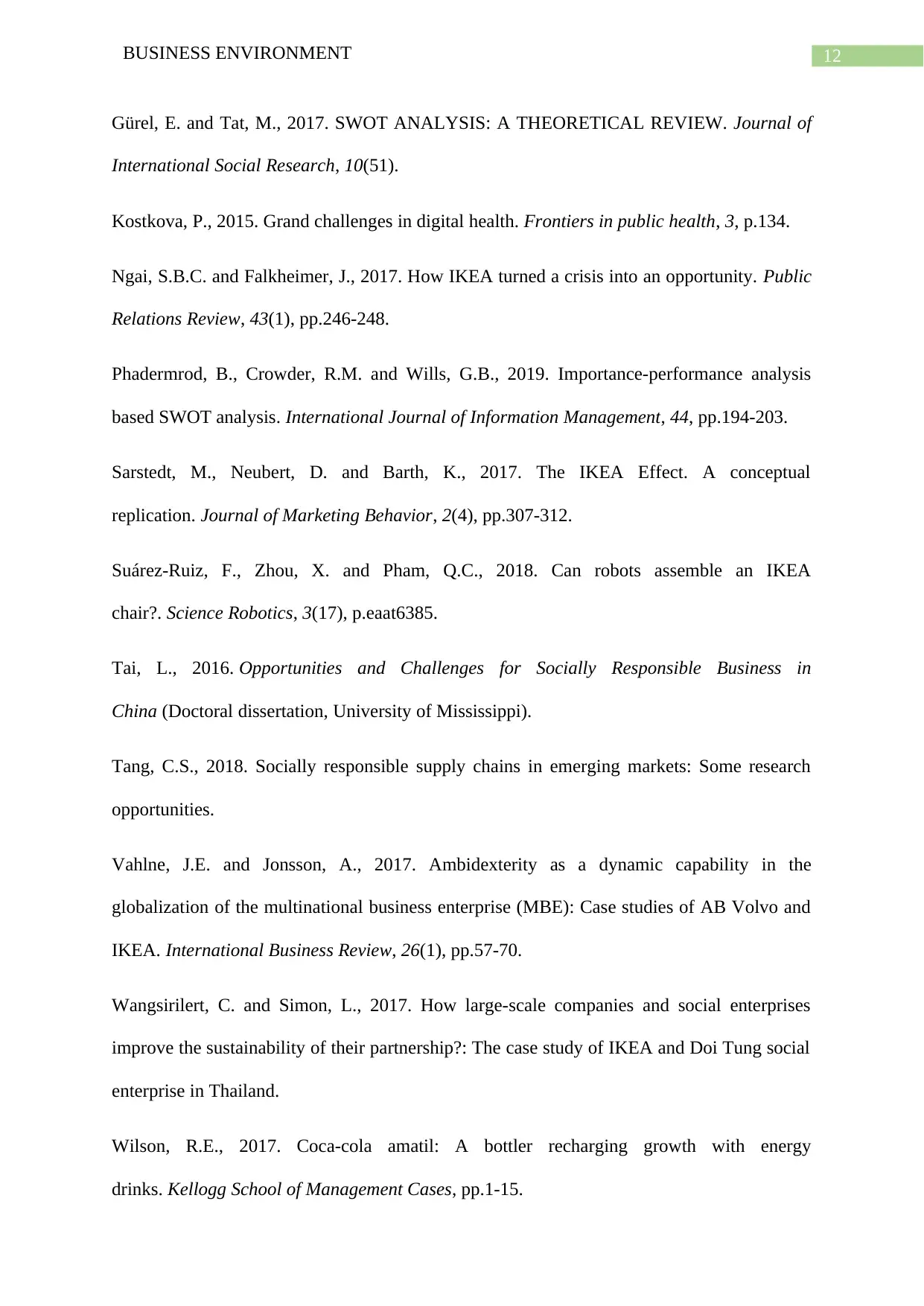
12BUSINESS ENVIRONMENT
Gürel, E. and Tat, M., 2017. SWOT ANALYSIS: A THEORETICAL REVIEW. Journal of
International Social Research, 10(51).
Kostkova, P., 2015. Grand challenges in digital health. Frontiers in public health, 3, p.134.
Ngai, S.B.C. and Falkheimer, J., 2017. How IKEA turned a crisis into an opportunity. Public
Relations Review, 43(1), pp.246-248.
Phadermrod, B., Crowder, R.M. and Wills, G.B., 2019. Importance-performance analysis
based SWOT analysis. International Journal of Information Management, 44, pp.194-203.
Sarstedt, M., Neubert, D. and Barth, K., 2017. The IKEA Effect. A conceptual
replication. Journal of Marketing Behavior, 2(4), pp.307-312.
Suárez-Ruiz, F., Zhou, X. and Pham, Q.C., 2018. Can robots assemble an IKEA
chair?. Science Robotics, 3(17), p.eaat6385.
Tai, L., 2016. Opportunities and Challenges for Socially Responsible Business in
China (Doctoral dissertation, University of Mississippi).
Tang, C.S., 2018. Socially responsible supply chains in emerging markets: Some research
opportunities.
Vahlne, J.E. and Jonsson, A., 2017. Ambidexterity as a dynamic capability in the
globalization of the multinational business enterprise (MBE): Case studies of AB Volvo and
IKEA. International Business Review, 26(1), pp.57-70.
Wangsirilert, C. and Simon, L., 2017. How large-scale companies and social enterprises
improve the sustainability of their partnership?: The case study of IKEA and Doi Tung social
enterprise in Thailand.
Wilson, R.E., 2017. Coca-cola amatil: A bottler recharging growth with energy
drinks. Kellogg School of Management Cases, pp.1-15.
Gürel, E. and Tat, M., 2017. SWOT ANALYSIS: A THEORETICAL REVIEW. Journal of
International Social Research, 10(51).
Kostkova, P., 2015. Grand challenges in digital health. Frontiers in public health, 3, p.134.
Ngai, S.B.C. and Falkheimer, J., 2017. How IKEA turned a crisis into an opportunity. Public
Relations Review, 43(1), pp.246-248.
Phadermrod, B., Crowder, R.M. and Wills, G.B., 2019. Importance-performance analysis
based SWOT analysis. International Journal of Information Management, 44, pp.194-203.
Sarstedt, M., Neubert, D. and Barth, K., 2017. The IKEA Effect. A conceptual
replication. Journal of Marketing Behavior, 2(4), pp.307-312.
Suárez-Ruiz, F., Zhou, X. and Pham, Q.C., 2018. Can robots assemble an IKEA
chair?. Science Robotics, 3(17), p.eaat6385.
Tai, L., 2016. Opportunities and Challenges for Socially Responsible Business in
China (Doctoral dissertation, University of Mississippi).
Tang, C.S., 2018. Socially responsible supply chains in emerging markets: Some research
opportunities.
Vahlne, J.E. and Jonsson, A., 2017. Ambidexterity as a dynamic capability in the
globalization of the multinational business enterprise (MBE): Case studies of AB Volvo and
IKEA. International Business Review, 26(1), pp.57-70.
Wangsirilert, C. and Simon, L., 2017. How large-scale companies and social enterprises
improve the sustainability of their partnership?: The case study of IKEA and Doi Tung social
enterprise in Thailand.
Wilson, R.E., 2017. Coca-cola amatil: A bottler recharging growth with energy
drinks. Kellogg School of Management Cases, pp.1-15.
1 out of 13
Related Documents
Your All-in-One AI-Powered Toolkit for Academic Success.
+13062052269
info@desklib.com
Available 24*7 on WhatsApp / Email
![[object Object]](/_next/static/media/star-bottom.7253800d.svg)
Unlock your academic potential
© 2024 | Zucol Services PVT LTD | All rights reserved.





